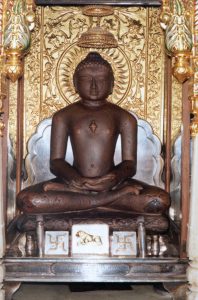Mahavir Jayanti:

The Prime Minister has greeted people on Mahavir Jayanti, recalling the noble teachings of Bhagwan Mahavir, especially the emphasis on peace, compassion and brotherhood
- Mahavir Jayanti is one of the most auspicious festivals in the Jain community.
- This day marks the birth of Vardhamana Mahavira, who was the 24th and the last Tirthankara who succeeded the 23rd Tirthankara, Parshvanatha.
- According to Jain texts, Lord Mahavira was born on the 13th day of the bright half of the moon in the month of Chaitra.
- As per the Gregorian calendar, Mahavir Jayanti is usually celebrated during the month of March or April.
- A procession is called with the idol of Lord Mahavira called the Rath Yatra.
- Reciting stavans or Jain prayers, statues of the lord are given a ceremonial bath called abhisheka.
Lord Mahavira:
- Mahavir was born to King Siddhartha of Kundagrama and Queen Trishala, a Lichchhavi princess in the year 540 BC in the Vajji kingdom, identical with modern day Vaishali in Bihar.
- Mahavira belonged to the Ikshvaku dynasty.
- There are several historians who believe that he was born in a place called Ahalya bhumi and the land has not been plowed for hundreds of years by the family that owns it.
- Lord Mahavir was named Vardhamana, which means “one who grows”.
- He abandoned worldly life at the age of 30 and attained ‘kaivalya’ or omniscience at the age of 42.
- Mahavira taught ahimsa (non-violence), Satya (truth), asteya (non-stealing), brahmacharya (chastity) and aparigraha (non-attachment) to his disciples and his teachings were called Jain Agamas.
- Ordinary people were able to understand the teachings of Mahavira and his followers because they used Prakrit.
- It is believed that the Mahavira passed away and attained moksha (liberation from the cycle of birth and death) at the age of 72 in 468 BC at a place called Pavapuri near modern Rajgir in Bihar.




